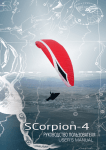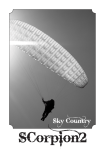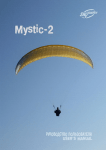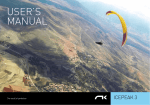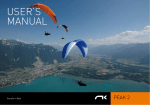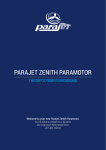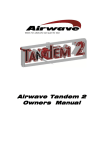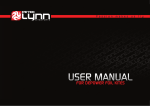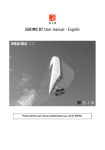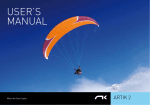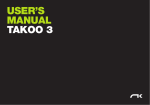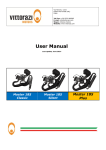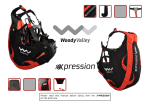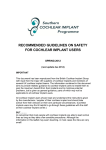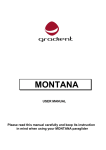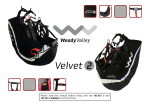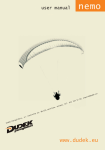Download Untitled
Transcript
SCorpion-3 Thank you for choosing SC Scorpion-3! This manual will help you to get maximum information about your glider. This is information about the design of the Scorpion-3, advice how to use it best and how to care for it to ensure it has a long life. The manual also includes technical specifications and line plans. We hope that the Scorpion-3 will give you a lot of wonderful flying hours. competitions acro paramotor school XC Scorpion-3 is suited for those pilots, who have at least 70 hours of flying expirience. The paraglider has good aerodynamic characteristics, which enables it to be used for cross-country flying, and even for flying competitions. Scorpion-3-26 is EN “C” certified. Warning! Paragliding is a high risk activity. We strongly recommend to learn paragliding only in certified schools and to choose only the equipment which is correspondent to Your flying skills. Technical data size 22 24,5 26 27,5 29 scale 0,906 0,956 0,985 1,013 1,04 22 24,5 26 27,5 29 11,3 11,93 12,29 12,64 12,98 wing area, sq.m. wing span, m. 5,81 aspect ratio projected area, sq.m. 20,46 21,59 22,24 22,87 23,48 projected span, m. 8,91 9,4 9,69 9,97 10,23 4,23 projected a/r root chord, m. 2, 431 2,565 2,643 2,718 2,791 tip chord, m. 0,419 0,442 0,456 0,469 0,482 90-115 100-130 cells 59 Vmin,km/h 25 Vmax,km/h 55 Vymin,m/s 1,0 in flight weight, kg/ 55-70 70-90 80-100 The total weight in flight is equal to the weight of the pilot and all the equipment including the wing. Usually - pilot weight + 15...17 kg. Materials Top surface: Gelvenor LCN 0066 OLKS/ Skytex 9017 E77A Bottom surface: Skytex 9017 E38A Ribs: Skytex 9017 E38A Leading edge reinforcements: Double laminated mylar Lines reinforcements: Dacron 170 g/sqm Top level lines: Cousin Dyneema 130 kg Bottom level lines: Cousin Aramid 160 kg, Liros Aramid 220, 280 kg Risers: polyester webbing 25mm, 1200 kg Connectors: 4 mm stainless Risers SCorpion-3 has the risers scheme A2A’1B4C3D2. The risers are equipped with speed system, that increases the speed range of the glider. Accelerator System Adjustment SCorpion-3 construction enables you to use it with an accelerator. To set up the accelerator on the ground: 1. Attach the risers to the harness. 2. Attach the accelerator. 3. Sit in your harness. 4. Ask a friend to pull your risers into their in-flight position. 5. While sitting in the harness, stretch your legs and push the loop of the accelerator as much as possible. (The rope will be stretched when pulled). 6. With your legs stretched, choose the length of the lead in such a way that accelerator harness is fully stretched and the pulleys on the risers touch. 7. Fix with a tie this length of the accelerator rope. The accelerator rope should not pull the accelerator in normal flight. Otherwise, the permanently-speeded-up paraglider will not provide the declared reliability for collapses. You must set up the accelerator properly and make sure it is not entangled! Pre-flight check - Lines are clear and leading edge is open - Karabiners and maillons are tight - All harness buckles are closed - Helmet on - Check reserve parachute - Accelerator bar is attached - Wind direction is perpendicular to the glider - Airspace is clear Warning! You are not allowed to change the paraglider construction except adjusting the brake lines, because it might lead to unpredictability in flying and make the paraglider dangerous in certain flying situations. You must never use SCorpion-3 for: - jumps; - tandem-flying; - any other purpose except flying. Launching Your SCorpion-3 can take-off with both forward and reverse techniques. Use forward technique when the wind is light, or there is no wind. Move forward and your glider will start to inflate. You must maintain a constant pressure on the risers until the wing is overhead. Brake it a little and launch. Use reverse technique in light to strong winds Pull the glider by its A-risers. When it is overhead, pull the brakes to stop the glider, then turn and launch. Practise ground handling a lot! It will help you feel your glider better. In Flight Characteristics Scorpion-3 has long brake travel, light brake pressure and turns very well. When accelerated Scorpion-3 remains solid and well-pressured. It also has high resistance to deflations in turbulence. Speed control You can change speed by simultaneously pulling or releasing the brakes. Flying at trim speed (hands up) your glider will achieve its best glide ratio. When brakes are pulled approximately 25 cm – you get its minimum sink rate. In order to increase your speed you can use the accelerator. Using accelerator Scorpion-3 reaches its maximum speed when you pull the accelerator to its maximum and release the brakes. Use this mode for long-distance flying and in strong winds. When using accelerator you will have a maximum speed of 55 km/h. Remember, that when you use the accelerator, your glider is more likely to collapse. We do not recommend to use accelerator, if your altitude is less, than 100m. If collapse occurs, release accelerator immediately. Turning In order to make Scorpion-3 turn with a minimum sink and radius while pulling the internal brake you should pull very slightly the external one too. Use weightshift to decrease the spiral radius. If the thermal flow is narrow and strong, increase the tilt and the rotation speed by releasing the external brake. When you need to turn fast, you should swing Scorpion-3 in the opposite direction and then pull as hard as needed the internal brake. Scorpion-3 has a brake travel about 80 см. When full stall is about to happen, the load at the brakes increases, and ensures that you know about it. Flying in turbulence You can help your glider to avoid different collapses in turbulence – you must fly actively for it. When the glider pitches forward – use the brakes to slow it, if it goes back – release brakes. These movements can be symmetric or asymmetric. Let us remind you once again that you should be very careful choosing the weather to fly. Descent Techniques Big Ears While holding the brakes you should symmetrically pull the outer А-lines(A’). For directional control of the glider use the weight shift. When you do big ears, the horizontal speed increases slightly. In order to return to normal flight, you should release the A-lines and pull the brakes a few times. Spiraling is not permitted with big ears, because of the increased load on the remaining lines so that they can be physically deformed. В-stall When you need to lose height quickly because of the sudden worsening of the weather, risk of entering a cloud, etc, we recommend you B-stall. Holding the brakes you take В-risers near the connectors. Forcefully but not suddenly, pull down the risers 25-30 cm and hold them as long as necessary. The wing gets a fold along the entire B-row and sinks at a rate of 8-10 m/sec. In order to return to normal flight simply release the В-risers and your Scorpion-3 will get out of the B-stall with a small front dive. You can use the brakes once the horizontal speed is gained. Scorpion-3 does not normally tend to go into deep stall once the B-risers are released. If this does happen (possibly for bad adjustment or under-loading), you should either pull the А-risers or swing the wing with the brakes. Spiral dive When you hold either brake down for a long time, the glider goes into a fast sharp turn and loses a lot of height. The rotation axis can be somewhere between the pilot and the wing. The sink rate could be more than 15 m/sec. To get out of the spiral dive you must release the inner brake. If the glider stays in deep spiral, pull the outer brake slightly to exit the maneuver. Do not pull the outer brake strong and fast – it may cause very dynamic exit. While spiral diving, the pilot experiences considerable overload up to 3 – 4g, so you can lose orientation. That is why we recommend spiral diving only when the sink rate of the В-stall is not enough. Landing In small winds, when you have 1-2 meters to the ground, you should pull the brakes gently to your arms’ full length, so that you put your Scorpion-3 in stall at a height of about 0.5 m and the horizontal speed is zero. In strong winds you must land facing the wind. If necessary you can fold the ears. As you approach the ground, you must take В-risers while holding the brakes. As soon as you hit the ground, you must turn towards the glider and pull B-risers running towards the wing. If the wing is flopping about a meter above the ground, release the B-risers and pull the brakes hard to your arms length. We do not recommend you to use the brakes in the strong wind, as the wing could catch the wind and pull the pilot. Do not let the glider overtake you and hit the ground with its front edge - it leads to increased pressure in the wing and may damage it. Deflations Frontal collapses Scorpion-3 comes out of symmetrical front collapse by itself. You can pull the brakes about a 20 cm to speed the re-inflation. Asymmetric collapses can be controlled by weight-shifting away from the collapse and applying a small amount of brake to control the flight direction. At the same time you should use the brake to re-inflate the canopy. If your Scorpion-3 collapses in accelerated flight, you must immediately release the accelerator to slow the glider down. Remember that the deflated glider has higher stall speed and smaller brake travel. That is why you should be careful not to pull the brake too hard to avoid stall. Full stall Full stall happens when you pull both brakes too hard. To return to the normal flight you must release both brakes. After this usually comes a front dive with a possible front deflation. Scorpion-3 warns the pilot about stalling by increasing the brake load. Deep stall (parachuting) To get out of this mode you must pull А – risers or swing the wing by pulling and releasing the brakes (preferably the first one). Asymmetrical stall It can take place when you pull one of the brakes too hard, or while spiraling at a small speed in turbulence you increase the angle of attack. Rotation in the asymmetrical stall is called negative spiral. This is one of the most dangerous flying situations. In order to get out of asymmetrical stall, just release the brakes. There may follow side thrust forward with a following wing collapse. Deflations Self-rotation Increasing rotation usually takes place when the pilot has not reacted properly to the asymmetric collapse of the accelerated paraglider. Try to slow down the rotation by counter-shifting your weight in the harness and pulling the outer brake. If the self-rotation is increasing, drop the rescue parachute quickly in the direction of the rotation. This mode can also take place when you make extreme turns of the overloaded paraglider. Cravat If the collapsed part of the canopy is entangled in the lines, you must try to release it by pulling the ear-line. If you cannot do it and the rotation is increasing, you must use the parachute. In flight damage Estimate the damage. If a brake has untied – no problem as Scorpion-3 can be steered well by weight shift and pulling the back risers. Even if the damage allows for a sustainable controlled flight, you should land as soon as possible. If normal flight is impossible, you must use the parachute. Packing Your glider Try to pack your SCorpion-3 as loosely as the rucksack allows, because every fold weakens the cloth. Special care should be taken about the rib reinforcements. Follow this scheme: Spread the glider on the ground the bottom surface up. Put all the lines onto the canopy. The risers can be placed both at the leading or at the trailing edge. Fold the canopy from the tips to center. Let the air come out from the canopy through the air intakes. Press the canopy gently from the trailing to the leading edge to bring out the residual air. Then roll it from the trailing to the leading edge. Avoid packing the glider if it is wet or contains the abrasive particles (sand, ice...). If the glider was packed wet and/or contains abrasive staff -- unpack it, let it dry and remove the trash from the canopy as soon as possible. General Glider Care Take care while using Your glider. The inappropriate and/or inaccurate use may cause the damage of the canopy and lines, and the glider may become dangerous in flight. Follow these rules and your SCorpion-3 will be in good condition: - Do not expose your SCorpion-3 to the sun any longer than necessary - Keep SCorpion-3 away from water and other liquids - Do not let the front edge hit the ground - If wet dry SCorpion-3 in shade. If soaked in salty water, rinse the glider thoroughly in non-salty water - Keep your SCorpion-3 away from fire - Do not put anything heavy on your glider, do not pack it in a rucksack too tightly. - Regularly inspect the canopy, lines, risers and harness. If you find any defects, contact your dealer or the manufacturer. Do not attempt to self-repair the paraglider! - If you detect a damaged line, inform the dealer or manufacturer about the line number according to the line plan - Keep your SCorpion-3 in a rucksack in a dry well-ventilated place under neutral temperature and humidity conditions - If you do not use SCorpion-3, then once a month you should unpack it, ventilate it well, and then pack it back in the rucksack. - Do not wash SCorpion-3. Do not use detergents or solvents. Clean dirty places with wet soft cloth or sponge. You can use this scheme, if you want to order the new line instead of damaged. Line plan Warrantee and Wing Repairs The producer guarantees the correctness of the declared characteristics and the paraglider’s normal performance for one year after the purchase date, but no more than 200 flying hours. The producer conducts special, and after-warranty repairs and maintenance at the owners’ request for an extra price. We recommend to inspect your paraglider (including checking suspension line strength, line geometry, riser geometry and permeability of the canopy material) one time at two years, or every 100 hours of flying time (whichever comes first); Those inspection must be made by manufacturer or dealer. If damaged, your SCorpion-3 must be repaired by manufacturer, or dealer. Small holes in Gelvenor fabrics you can repair with silicon clue and a peace of Gelvenor cloth. Small holes in Skytex may be repaired with sticky rip-stop tape. Attention please! The producer bears no responsibility for non-compliance with the stated characteristics if: - the user manual is not followed; - the paraglider structure is changed in any way; - the paraglider is self-repaired. Serial number Production date Test pilot Dealer Date SCorpion-3 Wing check and repairs information Flight test report Manufacturer Sky Country Certification number PG_0166.2008 Address _ _ Kharkov Ukraine Date of flight test 02. 07. 2008 Representative None Place of test Villeneuve Glider model Scorpion-3 26 Classification C Trimmer no Test pilot Thurnheer Claude Zoller Alain Harness Advance - Progress light Sup'Air - Evo XC L Total weight in flight (kg) 80 1. Inflation/Take-off 100 A Rising behaviour Smooth, easy and constant rising A Smooth, easy and constant rising A Special take off technique required No A No A A No A 2. Landing A Special landing technique required No 3. Speed in straight flight B Trim speed more than 30 km/h Yes A Yes A Speed range using the controls larger than 10 km/h Yes A Yes A Minimum speed Less than 25 km/h A 25 km/h to 30 km/h B 4. Control movement A Increasing / greater than 55 cm A not available 0 not available 0 Increasing / greater than 60 cm A Max. weight in flight up to 80 kg Symmetric control pressure / travel Max. weight in flight 80 kg to 100 kg Symmetric control pressure / travel Max. weight in flight greater than 100 kg Symmetric control pressure / travel not available 0 not available 0 5. Pitch stability exiting accelerated flight A Dive forward angle on exit Dive forward less than 30° A Dive forward less than 30° A Collapse occurs No A No A 6. Pitch stability operating controls during accelerated flight A Collapse occurs No 7. Roll stability and damping A Oscillations Reducing 8. Stability in gentle spirals A Tendency to return to straight flight Spontaneous exit 9. Behaviour in a steeply banked turn B Sink rate after two turns More than 14 m/s 10. Symmetric front collapse A A No A A Reducing A A Spontaneous exit A B More than 14 m/s B Entry Rocking back less than 45° A Rocking back less than 45° A Recovery Spontaneous in less than 3 s A Spontaneous in less than 3 s A Dive forward angle on exit / Change of course Dive forward 0° to 30° / Keeping course A Dive forward 0° to 30° / Keeping course A Cascade occurs No A No A Entry not available 0 not available 0 Recovery not available 0 not available 0 With accelerator Flight test report: PG_0166.2008 / page 1 of 3 not available 0 not available 0 Cascade occurs not available 0 not available 0 11. Exiting deep stall (parachutal stall) Dive forward angle on exit / Change of course A Deep stall achieved Yes A Yes A Recovery Spontaneous in less than 3 s A Spontaneous in less than 3 s A A Dive forward angle on exit Dive forward 0° to 30° A Dive forward 0° to 30° Change of course Changing course less than 45° A Changing course less than 45° A Cascade occurs No A No A 12. High angle of attack recovery A Recovery Spontaneous in less than 3 s A Spontaneous in less than 3 s A Cascade occurs No A No A 13. Recovery from a developed full stall A A Dive forward angle on exit Dive forward 0° to 30° A Dive forward 0° to 30° Collapse No collapse A No collapse A Cascade occurs (other than collapses) No A No A Less than 45° A Less than 45° A Line tension Most lines tight A Most lines tight A 14. Asymmetric collapse Rocking back C A With 50% collapse Change of course until re-inflation / Maximum dive forward or roll angle Less than 90° / Dive or roll angle 15° to 45° A Less than 90° / Dive or roll angle 15° to 45° Re-inflation behaviour Spontaneous re-inflation A Spontaneous re-inflation A Total change of course Less than 360° A Less than 360° A Collapse on the opposite side occurs No A No A Twist occurs No A No A Cascade occurs No A No A Change of course until re-inflation / Maximum dive forward or roll angle 90° to 180° / Dive or roll angle 15° to 45° B 90° to 180° / Dive or roll angle 15° to 45° B Re-inflation behaviour Spontaneous re-inflation A Spontaneous re-inflation A Total change of course Less than 360° A Less than 360° A Collapse on the opposite side occurs No A No A With 75% collapse Twist occurs No A No A Cascade occurs No A No A B With 50% collapse and accelerator Change of course until re-inflation / Maximum dive forward or roll angle Less than 90° / Dive or roll angle 45° to 60° C 90° to 180° / Dive or roll angle 15° to 45° Re-inflation behaviour Spontaneous re-inflation A Spontaneous re-inflation A Total change of course Less than 360° A Less than 360° A A Collapse on the opposite side occurs No A No Twist occurs No A No A Cascade occurs No A No A Change of course until re-inflation / Maximum dive forward or roll angle 90° to 180° / Dive or roll angle 45° to 60° C 180° to 360° / Dive or roll angle 15° to 45° C Re-inflation behaviour Spontaneous re-inflation A Spontaneous re-inflation A A With 75% collapse and accelerator Total change of course Less than 360° A Less than 360° Collapse on the opposite side occurs No A No A Twist occurs No A No A Cascade occurs No A No A 15. Directional control with a maintained asymmetric collapse A Able to keep course Yes A Yes A 180° turn away from the collapsed side possible in 10 s Yes A Yes A A More than 50 % of the symmetric control travel A A No A Amount of control range between turn and stall or spin More than 50 % of the symmetric control travel 16. Trim speed spin tendency A Spin occurs No Flight test report: PG_0166.2008 / page 2 of 3 17. Low speed spin tendency A Spin occurs No A No A 18. Recovery from a developed spin A Spin rotation angle after release Stops spinning in less than 90° A Stops spinning in less than 90° A Cascade occurs No A No A 19. B-line stall A Change of course before release Changing course less than 45° A Changing course less than 45° A Behaviour before release Remains stable with straight span A Remains stable with straight span A Recovery Spontaneous in less than 3 s A Spontaneous in less than 3 s A Dive forward angle on exit Dive forward 0° to 30° A Dive forward 0° to 30° A Cascade occurs No A No A 20. Big ears A Entry procedure Dedicated controls A Dedicated controls A Behaviour during big ears Stable flight A Stable flight A Recovery Spontaneous in less than 3 s A Spontaneous in less than 3 s A Dive forward angle on exit Dive forward 0° to 30° A Dive forward 0° to 30° A 21. Big ears in accelerated flight A Entry procedure Dedicated controls A Dedicated controls A Behaviour during big ears Stable flight A Stable flight A Recovery Spontaneous in less than 3 s A Spontaneous in less than 3 s A Dive forward angle on exit Dive forward 0° to 30° A Dive forward 0° to 30° A Behaviour immediately after releasing the accelerator while maintaining big ears Stable flight A Stable flight A 22. Behaviour exiting a steep spiral C Tendency to return to straight flight Spontaneous exit A Spontaneous exit A Turn angle to recover normal flight Less than 720°, spontaneous recovery A 720° to 1080°, spontaneous recovery C Sink rate when evaluating spiral stability [m/s] 18 23. Alternative means of directional control A 180° turn achievable in 20 s 24 Yes A Yes A Stall or spin occurs No A No A 24. Any other flight procedure and/or configuration described in the user's manual 0 0 Procedure works as described not available 0 not available Procedure suitable for novice pilots not available 0 not available 0 Cascade occurs not available 0 not available 0 25. Comments of test pilot Comments Front collapse full speed is not� possible to make propely. The� centre of the leading edge stay� every time open! Front collapse full speed is not possible to make propely. The centre of the leading edge stay every time open. Flight test report: PG_0166.2008 / page 3 of 3 Class: C PG_0166.2008 28. 07. 2008 In accordance with EN standards 926-2:2005 & 926-1:2006: Date of issue (DMY): Manufacturer: Model: Sky Country Scorpion-3 26 Serial number: Configuration during flight tests Paraglider Accessories Maximum weight in flight (kg) 100 Range of speed system (cm) 17 Minimum weight in flight (kg) 80 Speed range using brakes (km/h) 14 Glider's weight (kg) 5.6 Range of trimmers (cm) 0 Number of risers 4 Total speed range with accessories (km/h) 30 Projected area (m2) 22.24 Harness used for testing (max weight) Inspections (whichever happens first) Harness type ABS Every two years, or 100 hours flying time Harness brand Sup'Air Warning! Before use refer to user's manual Harness model Evo XC L Person or company having presented the glider for testing: None Harness to risers distance (cm) 50 Distance between risers (cm) 45 1 2 3 4 5 6 7 8 9 10 11 12 13 14 15 16 17 18 19 20 21 22 23 24 A A B A A A A A B A A A A C A A A A A A A C A 0






















